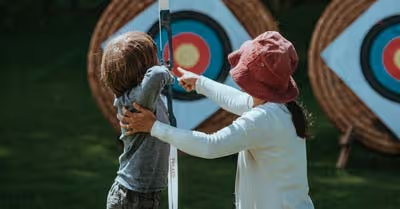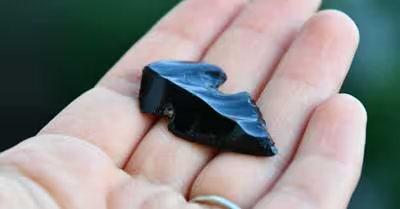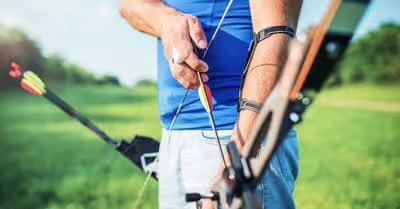Table of Contents
Do you need special equipment for 3D archery?
You do not need a special bow for 3D archery. If you have a bow that works well for target archery, it will work just as well on a 3D archery trail. If you do not already have a bow, it does not cost a fortune to get a compound or recurve bow for regular or 3D target shooting.
As well as a bow and arrows, you might also bring binoculars. Each target has scoring rings on it, and if you look at a target with binoculars, you can be sure where to hit it for the most points.
Bring anything else that is useful for someone who will be outside all day. Dress appropriately for the weather. Bring sunscreen on a bright summer day, dress more warmly in the spring and fall.
Wear footwear appropriate for the outdoors, such as hiking boots. You might also bring food, a water bottle, bug spray, or sunglasses.
Be prepared to shoot in less than ideal conditions
If it starts raining, the tournament will not be canceled. Bring an umbrella with you. You should be able to shoot well outside of ideal weather conditions - that is part of the sport.
You might not encounter rain, but there could still be wind that you will have to adjust your aim for. There could also be clouds, so you may have to shoot when the light is not ideal. There are many challenges to overcome in 3D archery that you won't find in target archery.
How does scoring work in 3D archery?
Since 3D archery is simulated hunting, you are supposed to hit the foam animals where their vital organs would be. Each animal has a scoring ring. The closer you get to the center of the target, the more points you earn.
There are two scoring systems, IBO scoring, and ASA scoring. You can earn 11, 10, 8, or 5 points per shot in IBO scoring, depending on where you hit the animal. Unless you miss the animal completely, you will earn some points.
If you miss the scoring ring but hit somewhere else on the foam animal, you will earn five points, with anywhere inside the scoring ring being worth eight or more points.
ASA scoring is slightly different and allows you to score 5, 8, 10, 12, or 14 points per shot. If you hit in the center of the target, you will earn 12 points.
If you hit a small spot near the edge of the scoring ring, you will earn 14. If you aim for the 14 point ring, you are more likely to miss the scoring ring and score only 5 points. The center in ASA scoring is not the best spot to hit.
If you earn ten points on each target on average, you have performed well, or "shot even." With 30 targets, 300 is a good (or even) score. If you score three points better than even, you score three points up, or two points down if you score two points less than even. It is harder to shoot even on some 3D archery courses than others.
If you barely manage to hit a certain part of the target, it thankfully counts as a hit. If your arrow touches the line of the bullseye ring, that is good enough to count as a bullseye. If the arrow touches the line, that counts as good enough for the number of points that area awards.
Unknown distance shooting
To succeed at 3D archery, you have to be capable of unknown distance shots. Usually, there are no signs with distance numbers in 3D archery.
You can sometimes use a range finder tool to calculate the distance yourself, although contests do not always allow these devices. Some tournaments even let you see distance numbers, but not many of them do. You should learn to shoot without knowing how far away the targets are.
Most targets in 3D archery are less than 50 yards away. The ranges used are similar to the most common ranges in bowhunting. You will not commonly encounter long or very short ranges.
Different tournaments have different rules
You can unintentionally break the tournament's rules if you don't know them. Look online and read the rules before participating. You can be disqualified if you do not follow the rules.
3D Archery is timed
You only have a limited amount of time to complete a 3D archery course. You might have to finish the whole course in less than three hours and ten minutes, or you might have only a minute or two minutes to do each shot. There is usually more than enough time to finish; you do not have to move and shoot quickly.
You can only take a single shot per target in 3D archery, so if you miss one target entirely, it is much harder to shoot even. You will take turns shooting with other shooters on the course with you. You must shoot from a specific spot that is clearly marked.
Make sure your equipment is in good condition before shooting
Make sure your bow is set up properly before you shoot. Do any necessary maintenance beforehand. Show up a few minutes early in case you need to do some last-minute fine-tuning.
3D archery for more competitive players
As you get better at the sport, you may become more competitive and choose to join a league. In a league, you will travel to different parts of the country and compete in contests. There are many different 3D archery leagues, many of which only involve traveling to different parts of the state and not any farther.
While 3D archery leagues are mostly for more advanced players, you do not have to be an expert to join a league. People in most leagues vary greatly in skill, and you may be able to do better than many of them before you are an expert. Every two years, there is a 3D archery world championship.
What kind of bows, arrows, and other gear are allowed?
Participants must use target points, as target archers use, and not broadheads, as hunters use. You are often allowed to choose from a lot of different types of bows and accessories for your bow, though some competitions are more restrictive.
Both the ASA and the IBO allow compound bows. Compound bows are what hunters use, and they are legal in these simulated hunting contests. If you prefer, you can also choose to use a recurve bow or a longbow in ASA or IBO tournaments.
In some cases, you might even be allowed to use a crossbow against compound bows and recurve bows, but don't count on being allowed to use one.
Different competitions have different rules. Some sights are usually allowed, as you are not expected to compete with very basic equipment. However, contests are quite likely to ban sights with lasers.
Tournaments are also likely to let you choose your own arrows. Many hunting arrows you can buy are allowed in tournaments. You might not be allowed to modify these arrows much or at all.
Arrows with a wide diameter might not be allowed. Very light arrows are not allowed in IBO competitions. There is a minimum weight relative to the bow's shooting weight.
Bows with a shooting weight that is too high might not be allowed. There can also be a limit on how fast your arrow can fly.
Many of these restrictions are for safety's sake. Many other limitations are for the sake of making everyone compete fairly with similar equipment.
3D archery can make you a better hunter
While practicing hunting is the best way to get better at bowhunting, bowhunters also practice with targets. Any kind of bow practice can work, but 3D archery is the best way to practice.
3D archery can help you learn to hit animals in their vital organs. You will also make sure that your equipment is working properly before the hunting season starts.
If you don't want to enter any contests yet, there is recreational 3D archery. In recreational 3D archery, you can move along the course at your own pace. If you enter a few amateur 3D archery tournaments, you can get used to shooting in higher pressure situations, which can help you when hunting.
Recent Articles
















